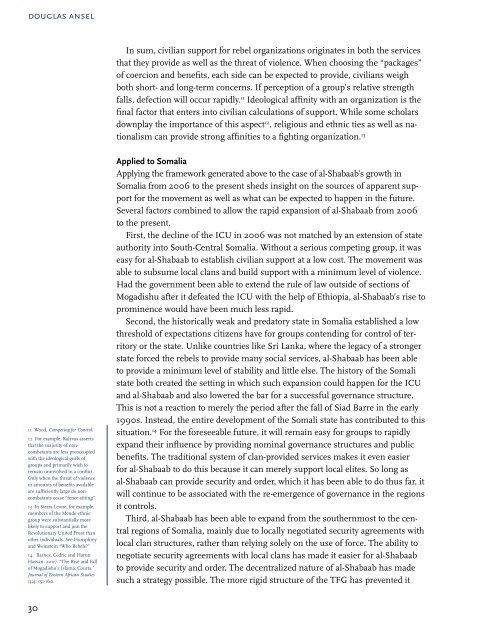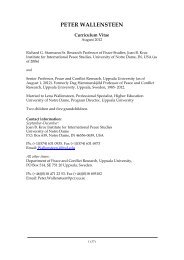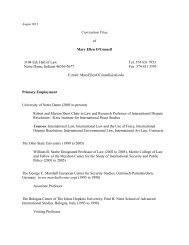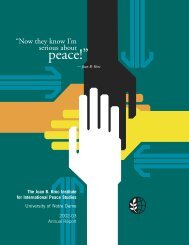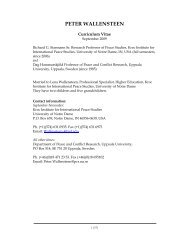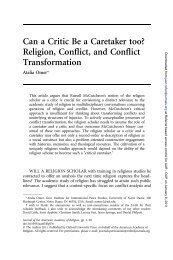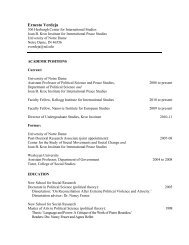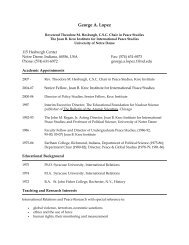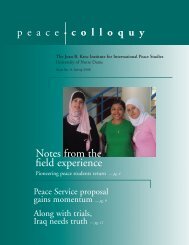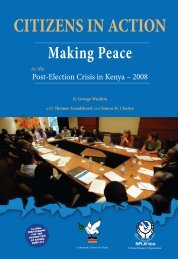Somalia: Creating Space for Fresh Approaches to Peacebuilding
Somalia: Creating Space for Fresh Approaches to Peacebuilding
Somalia: Creating Space for Fresh Approaches to Peacebuilding
You also want an ePaper? Increase the reach of your titles
YUMPU automatically turns print PDFs into web optimized ePapers that Google loves.
douglas ansel<br />
11 Wood, Competing <strong>for</strong> Control.<br />
12 For example, Kalyvas asserts<br />
that the majority of noncombatants<br />
are less preoccupied<br />
with the ideological goals of<br />
groups and primarily wish <strong>to</strong><br />
remain uninvolved in a conflict.<br />
Only when the threat of violence<br />
or amounts of benefits available<br />
are sufficiently large do noncombatants<br />
cease “fence-sitting”.<br />
13 In Sierra Leone, <strong>for</strong> example,<br />
members of the Mende ethnic<br />
group were substantially more<br />
likely <strong>to</strong> support and join the<br />
Revolutionary United Front than<br />
other individuals. See Humphrey<br />
and Weinstein “Who Rebels?”<br />
14 Barnes, Cedric and Harun<br />
Hassan. 2007. “The Rise and Fall<br />
of Mogadishu’s Islamic Courts.”<br />
Journal of Eastern African Studies<br />
1(2): 151-160.<br />
30<br />
In sum, civilian support <strong>for</strong> rebel organizations originates in both the services<br />
that they provide as well as the threat of violence. When choosing the “packages”<br />
of coercion and benefits, each side can be expected <strong>to</strong> provide, civilians weigh<br />
both short- and long-term concerns. If perception of a group’s relative strength<br />
falls, defection will occur rapidly. 11 Ideological affinity with an organization is the<br />
final fac<strong>to</strong>r that enters in<strong>to</strong> civilian calculations of support. While some scholars<br />
downplay the importance of this aspect 12 , religious and ethnic ties as well as nationalism<br />
can provide strong affinities <strong>to</strong> a fighting organization. 13<br />
Applied <strong>to</strong> <strong>Somalia</strong><br />
Applying the framework generated above <strong>to</strong> the case of al-Shabaab’s growth in<br />
<strong>Somalia</strong> from 2006 <strong>to</strong> the present sheds insight on the sources of apparent support<br />
<strong>for</strong> the movement as well as what can be expected <strong>to</strong> happen in the future.<br />
Several fac<strong>to</strong>rs combined <strong>to</strong> allow the rapid expansion of al-Shabaab from 2006<br />
<strong>to</strong> the present.<br />
First, the decline of the ICU in 2006 was not matched by an extension of state<br />
authority in<strong>to</strong> South-Central <strong>Somalia</strong>. Without a serious competing group, it was<br />
easy <strong>for</strong> al-Shabaab <strong>to</strong> establish civilian support at a low cost. The movement was<br />
able <strong>to</strong> subsume local clans and build support with a minimum level of violence.<br />
Had the government been able <strong>to</strong> extend the rule of law outside of sections of<br />
Mogadishu after it defeated the ICU with the help of Ethiopia, al-Shabaab’s rise <strong>to</strong><br />
prominence would have been much less rapid.<br />
Second, the his<strong>to</strong>rically weak and preda<strong>to</strong>ry state in <strong>Somalia</strong> established a low<br />
threshold of expectations citizens have <strong>for</strong> groups contending <strong>for</strong> control of terri<strong>to</strong>ry<br />
or the state. Unlike countries like Sri Lanka, where the legacy of a stronger<br />
state <strong>for</strong>ced the rebels <strong>to</strong> provide many social services, al-Shabaab has been able<br />
<strong>to</strong> provide a minimum level of stability and little else. The his<strong>to</strong>ry of the Somali<br />
state both created the setting in which such expansion could happen <strong>for</strong> the ICU<br />
and al-Shabaab and also lowered the bar <strong>for</strong> a successful governance structure.<br />
This is not a reaction <strong>to</strong> merely the period after the fall of Siad Barre in the early<br />
1990s. Instead, the entire development of the Somali state has contributed <strong>to</strong> this<br />
situation. 14 For the <strong>for</strong>eseeable future, it will remain easy <strong>for</strong> groups <strong>to</strong> rapidly<br />
expand their influence by providing nominal governance structures and public<br />
benefits. The traditional system of clan-provided services makes it even easier<br />
<strong>for</strong> al-Shabaab <strong>to</strong> do this because it can merely support local elites. So long as<br />
al-Shabaab can provide security and order, which it has been able <strong>to</strong> do thus far, it<br />
will continue <strong>to</strong> be associated with the re-emergence of governance in the regions<br />
it controls.<br />
Third, al-Shabaab has been able <strong>to</strong> expand from the southernmost <strong>to</strong> the central<br />
regions of <strong>Somalia</strong>, mainly due <strong>to</strong> locally negotiated security agreements with<br />
local clan structures, rather than relying solely on the use of <strong>for</strong>ce. The ability <strong>to</strong><br />
negotiate security agreements with local clans has made it easier <strong>for</strong> al-Shabaab<br />
<strong>to</strong> provide security and order. The decentralized nature of al-Shabaab has made<br />
such a strategy possible. The more rigid structure of the TFG has prevented it


